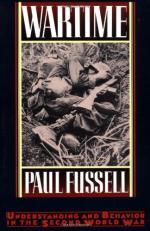
|
| Name: _________________________ | Period: ___________________ |
This test consists of 5 multiple choice questions, 5 short answer questions, and 10 short essay questions.
Multiple Choice Questions
1. How completely did the mainstream media cover events of the war?
(a) Their coverage was irregular and random.
(b) They tried hard to tell the whole story.
(c) They covered small pieces from all sides of the story.
(d) They covered only a small part of the story.
2. How did the media handle the worst aspects of the war?
(a) By covering them up.
(b) By ignoring them.
(c) By attributing them to the enemy.
(d) By using euphemisms.
3. The soldiers' primary sources of information primarily focused on what subject?
(a) The enemy.
(b) Military intelligence.
(c) The war effort.
(d) The conditions at home.
4. Who was the editor of Horizon?
(a) Nigel Dennis.
(b) Anthony Edwards.
(c) Stanley Milgram.
(d) Cyril Connolly.
5. Which of the following is NOT one of the things that the author states to have been almost totally marred by high-mindedness during the war?
(a) Prose.
(b) Poetry.
(c) Films.
(d) Reporting.
Short Answer Questions
1. Most soldiers believed that their actual wartime experiences would be reported when?
2. The media presented a view wherein the suffering of the nation's citizenry was linked to what?
3. When were most enduring war novels written?
4. What was one innovation in book publishing that came out of the war?
5. What practice became popular at home during the war?
Short Essay Questions
1. How did the media imply God's involvement in the war?
2. What does the author believe about the phenomenon of attributing high-minded ideals to the purpose of a war?
3. Overall, what was the media portrayal of the war like?
4. How often did soldiers read and what impact did it have on them?
5. What was the importance of the literary journal Horizon?
6. How and why did the media fail to report the entire story of the war?
7. What critical knowledge did an average soldier typically lack?
8. What were the most important types of media during the war?
9. What did front line troops usually believe about depictions of their wartime experiences?
10. What qualities caused an idiom to transfer to enter the general vocabulary?
|
This section contains 614 words (approx. 3 pages at 300 words per page) |

|




